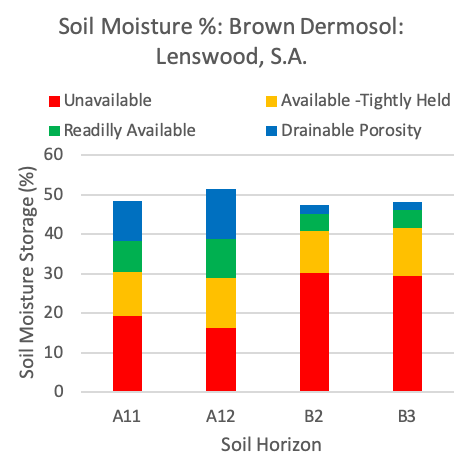Soil Hydrology
Site
SA3 - Lenswood 3
Region
Adelaide Hills, South Australia
Soil Type
Brown Dermosol
Soil Hydrology Overview
This data reflects both the quality of the soil structure, the amount of water available for growth and the ease by which these soils are able to be irrigated. The data indicates how much water is available for vigorous tree and fruit growth, as well as how much water is available for tree maintenance and survival. This data can also be used to better schedule irrigation, and compare irrigation requirements between soils.
The topsoil (A11 horizon) appears to be slightly compact having a bulk density of 1.35 g/cm3, which is slightly higher than the underlying A12 horizon at 1.29 g/cm3. However, all other measures indicate the A11 and A12 horizons are well structured. The drainable porosity of the A11 horizon at 10.0 %, and the A12 horizon at 12.7 % is ideal, which indicates the two A1 horizons have an abundance of macropores. The high saturated hydraulic conductivity at 383 mm/hr indicates the macropores are highly connected and functional, the outcome of which is that the two A1 horizons are well oxygenated and are able to rapidly infiltrate and drain irrigation or rainfall. Despite being well structured and having a high total soil water content the A11 and A12 horizons contain only a moderate amount of plant available soil water (PAWC) at 19.2% to 22.5 % or 73.7 mm to 36 cm depth, of which the readily available soil water for rapid tree and fruit growth is only 7.9 % to 9.7 % or 30.9 mm to 36 cm depth. The two B horizon differ to the A1 horizons in that they have minimal drainable porosity at 2.4 % and 2.1 %, lower readily available water at 4.3 % and 4.4 %, and substantially higher unavailable soil moisture at 30.1 % and 29.4 %, and saturated hydraulic conductivity between 3.18 mm/hr and 0.01 mm/hr. The majority of water in the B2 and B3 horizons is unavailable for tree use, yet a similar readily available soil water content at 28.9 mm to that of the A horizons.
Soil Hydrology Table
Available Soil Moisture
The soil profile to 100 cm depth is able to hold 447 mm soil moisture,of which 231 mm is unavailable for tree use. However, of this total moisture the amount of water which is actually available to the trees (plant available water content – PAWC, Green and Orange in figures) is only 163 mm, whilst the moisture used for rapid plant growth (readily available water- Green in figures) is moderate to high at 55 mm.




